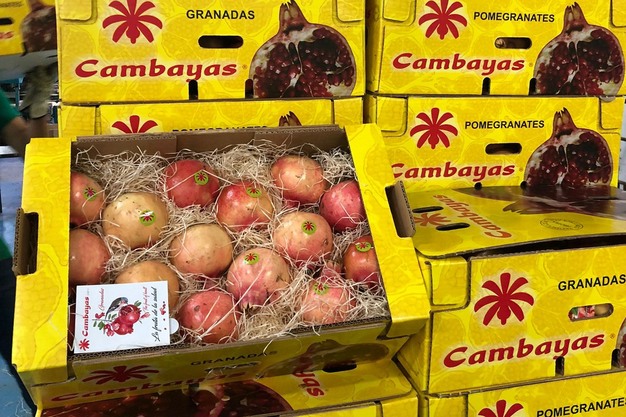The Spanish pomegranate season has started earlier this year as a result of the high demand at the beginning of August due to a production gap in the markets and the fruit's premature ripening. After a month of early red-skinned varieties, now the harvest and packaging have started for the native Valenciana variety, which has paler skin and arils, but a sweeter flavour and edible seeds.
"We have been harvesting and selling pomegranates since August 10, mainly of the Acco and Tastem varieties, of which we have already harvested around 70%, and we will continue to supply them throughout September," says Susi Bonet, from the sales department of the Cambayas cooperative, located in the municipality of Elche.

Valencian pomegranate.
"We've started packing the first Valenciana pomegranates, which are hitting the markets at the start of week 37. This is a much awaited variety because, traditionally, it is the native variety with which the pomegranate season starts in the Valencian Community, preceding the Mollar variety," says Susi Bonet. "Some clients even prefer to wait for this variety to be ready, because of its sweet and pleasant flavour, and avoid other earlier varieties with a sourer taste."
"The pomegranate season started with a higher demand than in the previous year because the Peruvian supply run out a lot earlier than usual," says the sales representative from this cooperative. "We have had four very good weeks of sales and the demand is still high, although the market only wants large sizes, weighting at least 300 grams a piece, and although the sizes were larger in the first harvests, now there is an abundance of smaller ones. Prices are higher, but this is a direct consequence of the constant increase in production costs."

According to Susi Bonet, the skin of a high percentage of fruit from the latest Valencian pomegranate harvest has been affected by the sun due to the heat waves this summer, which will lead to less production being sorted as first class and more pomegranates being of inferior class or going to the processing industry.
The Mollar pomegranate harvest is expected to start from October 15 and the extent of the impact of a new thrips from South Africa, Scirtothrips aurantii, which is also affecting citrus and kakis, is still being assessed. "There are fields where the fruit is in perfect condition, but others where everything or a high percentage of the production has been damaged," says Susi Bonet.
 For more information:
For more information:
Susi Bonet
CAMBAYAS COOP.V
Tel.: +34 966637588
susi@cambayas.com
www.cambayas.com
